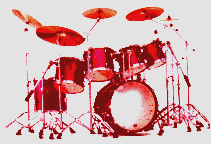 

Lesson Menu #2
Intermediate & Advanced.
Lesson Menu #3
Advanced & Ultra-Advanced.
Lesson Menu #4
Text lessons: All levels.

PRODUCTS:

GET ALL THE PRODUCTS AT ONE LOW PRICE.

SURPRISES ABOUND . . . For those with a bit of generosity
in their soul.
CLICK HERE , to see what I mean.

Intermediate & Advanced
Drummers
 Your future is waiting.
Your future is waiting.

ALL MUSICIANS
MASTER
ALL RHYTHM,
This FASCINATING WAY!
 Discover the 'LOST KEY' for Unraveling
ALL the mysteries of rhythm, and musical time.
Discover the 'LOST KEY' for Unraveling
ALL the mysteries of rhythm, and musical time.
This work
is the crowning-achievement of my 50 year career, and it's
my proudest accomplishment.
It contains the potential to help YOU change the face of modern music!
You'll love it! CLICK HERE to check it
out completely! You're in for a MAJOR surprise!
 "PRE-SCHOOL DRUMMER?
"PRE-SCHOOL DRUMMER?
YES!"
Can we teach rhythm
to pre-schoolers? YES!

This is a very short course,
designed to help adults plant the seeds of rhythm
into children of nearly any age.
CLICK HERE
 FREE ELECTRONIC BOOK BONUS (also included)
FREE ELECTRONIC BOOK BONUS (also included)
 BUSINESS OPPORTUNITY:
BUSINESS OPPORTUNITY:
MAKE BIG MONEY SELLING USED DRUMSETS!
* INSIDER HARDBALL-BUYING-TIPS AND SECRETS.
* UNIQUE RECOVERING SECRETS

Support this site and and gain an advetising bargain with the deal.
 Place a permanent ad here. Place a permanent ad here.

GET ALL THE PRODUCTS AT ONE LOW PRICE.

SURPRISES ABOUND . . . For those with a bit of generosity
in their soul.
CLICK HERE , to see what I mean.

|
|
Downloads *
Drummers Trivia *
Drummers Chat Rooms *
Rudiments *
Digital Music *
Knowledge Assessments *
TD Archives *
Drum Set Buyers Guide *
Bass-Player Jokes *
Assembling a Drum Set *
Parts of a Drum Set *
About HSID *
Video Troubleshooter
Bill Powelson's School of Drums
School of Drums
*** DRUM SET ASSEMBLY ***
Out of the UPS Box

 Don't miss the goldmine of free drum set lessons w/video. Don't miss the goldmine of free drum set lessons w/video.
Be sure to look into each of the lesson menus on the left, while you are here. It's a $2,000 course, for free!

HOW TO ASSEMBLE A DRUM SET FROM THE BOX:
In this little article, I want to help you put
that new kit together. So, lets get started . . .
Before you do anything . . . take a long look at
the following web page, How To Tune Your Drum Set'
Digest all that material first, because you may want to
tune as you go, especially as you put the Bass Drum together.
Your drums may arrive completely dis-combobulated in one
or more boxes. Take everything out of the box or boxes,
and lay the pieces out on the floor, prior to assembly.
START WITH THE BASS DRUM:
- 1. The bass drum shell is probably the biggest item
in the biggest box. Take it out of the box and pull the
protective plastic covering off, if there is any.
- 2. Take a long look! Do you know the front from the
back? Don't laugh! There is a difference! The 'back' is
the part your pedal will beat on. The front then, will be
on the opposite side.
You can tell the front from the back by finding the
where the 'spurs' will go. Look for two holes at the base
of the shell. The Spurs are the two legs that
keep the drum from tipping, or sliding, when it is struck from behind.
So, the spurs go in front and make contact with the floor
or carpet. These two 'spurs' will help stabilize the bass
drum and keep it from rolling from right to left, too.
- 3. Look for the spurs in all your neatly arranged pieces and
parts. They will look like short legs made of chrome. Normally
they may be anywhere from 4" to 15" in length. The spurs, once
you find them, usually just slide into a mount of some sort on the
front of the bass drum at the base of the shell like i said earlier.
They are normally designed to protrude from inside the drum and will be
adjustable to the length needed for stabilization and grip with
the floor or carpet. The 'spurs' are usually held in place with
some type of screw device or wing nut. Not all drums are designed
the same, so you will just have to figure out how they attach to
your specific drum set, then adjust them so that they do their
job, as intended.
**************************************************
 Check out the courses (products) in the left column! You can get ALL of them free, with a simple donation
of $45.00 or more. Most of those courses will show you how to put the $45 right back into your
own pocket, A THOUSAND TIMES! Check out the courses (products) in the left column! You can get ALL of them free, with a simple donation
of $45.00 or more. Most of those courses will show you how to put the $45 right back into your
own pocket, A THOUSAND TIMES!
BUY ONE PRODUCT, GET ALL THE OTHERS FOR FREE!
Plus, you'll receive a downloable copy of this entire course that may easily be burned to a CD.
**************************************************
Now we are ready to assemble the back bass drum head.
'BACK' HEAD, FIRST:
- Look through and find two of the largest drum heads
that came in the largest box. If they both look exactly the
same then it doesn't matter which goes where. However, if one
of the bass heads has a round hole cut in it, that will mean
it should go on the front. You will be installing the back head
first (the bass pedal side), so be sure you have the right one.
If only one head has manufacturers logo on it, that will be
the front head. Usually both will have a logo.
- Now, determine where the top of the bass drum is. You
will know the top by finding a special chrome tom-tom mounting
assembly.
- Place the bass drum head over the rim of the bass drum shell,
as the drum lays face down, front to the floor.
- Slide or adjust the head so that the logo (if there is any)
looks right. Usually the Logo (ie; Pearl, Remo, Ludwig, etc.) goes
at the top and is centered with the tom mount assembly. You can
simply eyeball it and get it right. The point here is that you
don't want people to have to stand on their head to read the logo,
upside down and backwards. If it looks right, it probably is!
SEATING THE HEAD:
- The ring of the drum head should fit snuggly over the lip
of the bass drum shell (if you have the correct drum head size.)
You may need to press it into place with your fingers. It is
usually a perfect (but very snug) fit, if all is well. Be sure
the head is all the way onto the drum, (down as far as it will go)
by pushing with your fingers and hands. Now it is starting to
look like a bass drum! :>)
- Is the logo on the head straight? Will it look correct
when the drum is upright, in the playing position? Center it
by eyeballing the tom mount apparatus.
- You are now ready to mount the head to the drum,
with the hoop and lug screws (or tension rods.)
MOUNTING THE DRUM HEAD:
- Look through all those pieces and parts again for two
very large hoops of chrome or wood. They will look something
like hula hoops and will be nearly the same diameter as the
bass drum.
- Lay either hoop onto the head as the drum is laying front to
the floor. Press down lightly all around the hoop. Use it to
help seat the drum head a bit more. Look for screw holes in the
hoop. Line those holes with the lugs on the shell of the bass
drum. The chrome lugs will each have a threaded 'female' screw
assembly that will accept the long rods or lug screws. These lug
screws fasten the hoop over the head and the shell of the drum.
By screwing them down evenly, we can pull the head tighter and
tighter. This helps achieve the tones we want when tuning the
drum. The tighter the drum head, the higher the pitch. Nearly
all drums are based on this same principle.
- FIND THE BASS DRUM LUG SCREWS (tension rods:)
Look for 6 or 8 (maybe 10) long screws. They may be 8"
to 10 inches long and usually will have a wing-nut type of
apparatus on one end, and they'll be threaded on the other.
- Glide the lug screws through the holes in the hoop, then into
the 'female' screw assembly of the lugs. Go all the way around
the back drum head doing this. Pull each lug screw down to about
the same tightness and try to keep all the lug screws at about the
same tension as you go. The drum tones will get higher and higher
as you apply more tension to each of the tension rods or lug screws.
- It is best to assemble in a criss-cross fashion so that the
head will seat evenly all around the drum as you tighten each screw.
You may hear some crackling and popping as the tension increases
with each turn of a screw. This is normal as the plastic drum heads
stretch to conform with the drum.
- Don't pull the head too tight though! This is a bass drum and you
probably won't want it to be 'pitched' all that high in tone. About
medium to loose tension is best. Tighten to a point where there are no
wrinkles in the head, then stop.
THE FRONT HEAD:
MOUNTING THE TOM TOMS:
Now, its back to the pieces and parts pile! Look for the
tom tom mounting post. There may be two separate posts, (one
for the right tom and another for the left.) It depends
on the brand of drums you have.
Insert the post (or posts) into the hole (or holes) on
top of the bass drum. Find a screwing device (usually a
large wing-nut) and secure the posts in place. If there is
any kind of logo stamped on the post it will face outward,
towards the potential crowd.
The posts are designed to be adjusted to the height and
arm-length of the player. You will need to experiment until
the best height (for you), has been determined.
Also, the arms that hold the toms are usually adjustable
many ways. This is another thing that needs experimentation.
Every drummer tends to want everything just so-so, his/her on
personal way.
PUT THE TOMS TOGETHER:
The different toms go together about the same way the bass
drum went together. Go ahead and put both heads on each drum.
They will probably sound somewhat 'boingy' if left unmuffled.
'Dead Ringers' or 'Sound Ovals' are the best remedy for that problem.
Ask for a demonstration of 'Sound Ovals' at your local music store,
the next time you go in. You can easily add them later if
you want and need them. My bet is . . . you probably will.
Common sense prevails here. As you assemble the different
toms, notice the lug screw lengths. Larger toms use longer
screws and versey vicey. Be sure you have the correct
lug screws going to the correct toms or this thing will get
humorous real quick, haha.
Look for a drum key . . . somewhere in all that mess of
pieces and parts. It will probably be a 'T' shaped tool that
works very much like an old-time skate key. It is a wrench, you
will use to tighten the lug screws of each drum to be assembled
and tuned.
Tune as you go (see the tuning lesson.) You'll want the smallest
toms to have the highest pitch and the largest toms to have the
lowest pitch in progressive order around the kit. The tones
you'll choose are arbitrary . . . it is up to the drummer! There is
no standard tuning for drummers. We all tend to know what we
want to hear, then we proceed to pull that tone from the drum.
Again, the tuning lesson may help you here.
You will want to mount the smallest tom on the left side of the
kit as you sit behind the set. The larger sized toms progress
around to the right, with the Floor Tom around on your far right
hand side sitting on the floor.
Just slip the toms onto the mounting arms of the post and
secure them with the provided (large) wing-nuts or whatever.
FLOOR TOM TOM:
Most Floor Toms have three legs that mount through a chrome
mounting device on the sides of the drum shell. Just slip the
legs through the leg holders and tighten them into place with
the wing nuts provided.
BASS PEDAL:
All Bass Drum pedals are a little different, but most
operate on the same principle. Usually, there will
be a tongue in groove type clamp, that bites into the hoop
of the bass drum as it sits on the floor in the playing
position. Just slip the pedal up to the hoop and look for a
way to attach it firmly to the drum so that it won't fall
away as it is being used. It is pretty much a common sense
thing.
STANDS:
There are millions of stand designs. It is hard for me to
second guess what you may have.
All stands are designed to be totally collapsible and adjustable, for easy
mobility and flexibility. There will be several stands in every drum kit.
SNARE STAND:
The snare stand will be the only stand in the bunch that even
looks capable of holding a snare drum. You should see a stand
with three adjustable arms that spread open wide enough for the snare
to be laid in place. Then, somewhere on the stand there will be
an adjustment device that will allow you to tighten the arms into
the drum and hold it securely.
CYMBAL STANDS:
They come in all shapes an sizes . . . some with boom arms,
others may be straight. All are always totally collapsible and
telescoping with adjustment screws everywhere.
Usually each stand is packaged with all its parts intact.
It is just a matter of common-sense to get all the adjustments
right for the person who will be playing the drums. Use your own
judgment here.
HI-HAT STAND:
Again, there are hundreds of designs.
Spread the tri-pod legs first . . . then attach
the foot pedal to the base of the stand according to
your own intuition.
Adjust the height of the stand intuitively according
to the size and stature of the player.
At the top of the hi-hat stand you will see a hole running
full length of the stand all the way through the tube (or shaft)
to the base of the stand. There will be a long rod that goes
through the shaft (or tube) and attaches (some way) to the pedal.
The idea is that as you press the pedal the rod will move up and
down, making two cymbals clap together at the top of the stand.
Now for the Cymbals . . .
The BOTTOM HI-HAT CYMBAL will cup upwards and lay on a
cushion, usually made of felt. You don't want metal to metal
anywhere. It will effect the tone. The cymbal will have a hole
in the center. Drop it down over the rod that comes up from the
floor through the shaft. Be sure the cymbal is cupping upwards.
Also, the heaviest of the two hi-hat cymbals should (usually) be
used as the bottom cymbal.
The TOP HI-HAT CYMBAL is usually the thinner of the two and
it will be set to cup downward into the bottom cymbal.
A HI-HAT CLUTCH is used to secure the top cymbal onto the
rod that comes up from the floor. The HI-HAT CLUTCH is normally
an assortment of washer-nuts, (they look like washers but are
usually threaded inside the center hole), felt cushions and maybe
a wing-nut. IT IS VERY HARD TO DESCRIBE IN WORDS! Anyway the
top cymbal needs to be sandwiched between felt cushions and
washer-nuts in such a way that it will hold the top cymbal
securely onto the rod coming from the base of the hi-hat by use
of the wing nut. The idea here again is that there should never
be metal to metal. Felt cushions are used to protect the cymbal
from the metal washer-nuts.
That's it! You are about ready to jam!
We left the front bass head off, on purpose.
Remember?
Grab a couple pillows, a blanket, or something and toss
them inside the bass, up against the batter head.
Now play awhile! How does everything sound? If you like
the way the bass is sounding then go ahead and put the front head
on, leave the packing as it is. Mom will be frantic looking for
those pillows and blankets! Just keep a straight face, and don't
say a word, haha. She'll never know!
Just kidding!!!! Don't do that!
If your bass tone isn't quite right though, keep experimenting
with different amounts of packing until you are satisfied.
SNARE RATTLE!!!!!
Yep! It goes with the gig, haha! And, it is very difficult to remedy!
A good snare rattles because it is sensitive! It is a part
of the design. The 'snares' or wires under the snare drum
are intended to vibrate and help produce that tone we all want.
The trouble is, almost any vibration in the room will set them
to singing and rattling. If we tape or tie them down, then
much of our snappy tone may be lost in the trade-off.
SEMI-SOLUTIONS:
About all we can do is shoot for a compromise!
- Pull the 'snares' as tight as you dare, using
the straining device on the side of your snare drum.
- Be sure that no two drum rims are touching. I
always like my toms VERY close, but there should be at least
a 1/2" inch gap between each drum. Otherwise, when you hit
one drum . . . the other will likely vibrate and rattle.
This is especially true if the snare rim is touching the hi-tom
rim.
- Sound Ovals: These are
thin mylar ovals designed to be laid on top of the batter head
of each drum. They do very well at killing the overtones and
excess ringing that occurs with all unmuffled drums. You
need to see a demonstration of how they work. Go harass your
local music store! They need the money! Tell them you would
like to see how Sound Ovals (aka; O-Rings) work, before you buy them. Try them
out on a demo set at the store. You'll drop about $15.00 to
$30.00 going around your kit with 'Sound Ovals' but it may be
the best tuning investment you will ever make.
Anyway, 'Sound Ovals' will do a lot towards controlling all
the unwanted vibrations and overtones. This will help to cut back
on snare rattle tremendously.
OK! You are all set up. Now, beat it!
****************************
Are you among the 95% good, or the 5% bad?
FIND OUT HERE . . .
****************************

International copyright secured @ Bill Powelson 1994 all rights reserved.
| |



